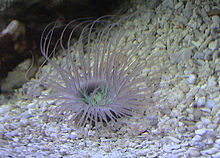Tube-dwelling anemone
| Tube-dwelling anemones | |
|---|---|

| |
| Cerianthus sp. | |
| Scientific classification | |
| Domain: | Eukaryota |
| Kingdom: | Animalia |
| Phylum: | Cnidaria |
| Subphylum: | Anthozoa |
| Subclass: | Ceriantharia |
| Subgroups | |
Tube-dwelling anemones or ceriantharians look very similar to sea anemones but belong to an entirely different class of anthozoans. They are solitary, living buried in soft sediments. Tube anemones live inside and can withdraw into tubes, which are composed of a fibrous material made from secreted mucus and threads of nematocyst-like organelles known as ptychocysts. Within the tubes of these ceriantharians, more than one polyp is present, which is an exceptional trait because species that create tube systems usually contain only one polyp per tube.[1] Ceriantharians were formerly classified in the taxon Ceriantipatharia along with the black corals[2] but have since been moved to their own class, Ceriantharia.
Ceriantharians have a crown of tentacles that are composed of two whorls of distinctly different-sized tentacles. The outer whorl consists of large tentacles that extend outwards. These tentacles taper to points and are mostly used in food capture and defense. The smaller inner tentacles are held more erect than the larger lateral tentacles and are used for food manipulation and ingestion.[3] The tentacles of Ceriantharians are also venomous, similar to Cnidarians, which allows them to protect themselves from predators. The recent exploration of Ceriantharians and their venomous tentacles permits the exploration of the lineage of venom genes in Anthozoas. [4]
A few species such as Anactinia pelagica are pelagic and are not attached to the bottom; instead, they have a gas chamber within the pedal disc, allowing them to float upside down near the surface of the water.[5][6]
Taxonomy
[edit]- Order Spirularia
- Family Botrucnidiferidae Carlgren, 1912[7]
- Genus Angianthula Leloup, 1964
- Genus Atractanthula Leloup, 1964
- Genus Botruanthus McMurrich, 1910
- Genus Botrucnidiata Leloup, 1932
- Genus Botrucnidifer Carlgren, 1912
- Genus Calpanthula van Beneden, 1897
- Genus Cerianthula Beneden, 1898
- Genus Gymnanthula Leloup, 1964
- Genus Hensenanthula van Beneden, 1897
- Genus Ovanthula van Beneden, 1897
- Genus Sphaeranthula Leloup, 1955
- Family Cerianthidae Milne-Edwards & Haime, 1852[8]
- Genus Anthoactis Leloup, 1932
- Genus Apiactis van Beneden, 1897
- Genus Bursanthus Leloup, 1968
- Genus Ceriantheomorphe Carlgren, 1931
- Genus Ceriantheopsis Carlgren, 1912
- Genus Cerianthus Delle Chiaje, 1830
- Genus Engodactylactis Leloup, 1942
- Genus Isodactylactis Carlgren, 1924
- Genus Nautanthus Leloup, 1964
- Genus Pachycerianthus Roule, 1904
- Genus Paradactylactis Carlgren, 1924
- Genus Parovactis Leloup, 1964
- Genus Peponactis van Beneden, 1897
- Genus Plesiodactylactis Leloup, 1942
- Genus Sacculactis Leloup, 1964
- Genus Solasteractis van Beneden, 1897
- Genus Synarachnactis Carlgren, 1924
- Genus Syndactylactis Carlgren, 1924
- Genus Trichactis Leloup, 1964
- Order Penicillaria[9]
- Family Arachnactidae McMurrich, 1910
- Genus Anactinia Annandale, 1909
- Genus Arachnactis Sars, 1846
- Genus Arachnanthus Carlgren, 1912
- Genus Dactylactis van Beneden, 1897
- Genus Isapiactis Carlgren, 1924
- Genus Isarachnactis Carlgren, 1924
- Genus Isarachnanthus Carlgren, 1924
- Genus Isovactis
- Genus Ovactis
- Genus Paranactinia
A 2020 integrative study incorporating molecular phylogenetic reconstructions and morphological assessment across the three families recovered Arachnactidae as a well-supported clade, but did not recover Cerianthidae and Botrucnidiferidae as monophyletic, drawing into question the validity of the Spirularia suborder[10]
References
[edit]- ^ Ceriello, Hellen; Costa, Gabriel G.; Bakken, Torkild; Stampar, Sérgio N. (October 2020). "Corals as substrate for tube-dwelling anemones". Marine Biodiversity. 50 (5): 89. Bibcode:2020MarBd..50...89C. doi:10.1007/s12526-020-01116-1. ISSN 1867-1616. S2CID 221885210.
- ^ Appeltans, Ward (2010). "Ceriantipatharia". WoRMS. World Register of Marine Species. Retrieved 2017-12-21.
- ^ Brusca, R.C. & Brusca, G.J. 2002. Invertebrates Second Edition Sinauer Associates. ISBN 0-87893-097-3
- ^ Stampar, S. N.; Broe, M. B., Macrander, J.; Reitzel, A. M.; Brugler, M. R.; Daly, M. (2019). "Linear Mitochondrial Genome in Anthozoa (Cnidaria): A Case Study in Ceriantharia". Scientific Reports. 9 (1): 6094–6094. Bibcode:2019NatSR...9.6094S. doi:10.1038/s41598-019-42621-z. PMC 6465557. PMID 30988357.
{{cite journal}}: CS1 maint: multiple names: authors list (link) - ^ Barnes, Robert D. (1982). Invertebrate Zoology. Philadelphia, PA: Holt-Saunders International. pp. 150–157. ISBN 0-03-056747-5.
- ^ Annandale, N. (1909). "A pelagic sea-anemone without tentacles". Records of the Indian Museum. 3 (10): 157–162.
- ^ Molodtsova, T. (2015). Botrucnidiferidae Carlgren, 1912. Accessed through: World Register of Marine Species on 2016-02-10.
- ^ Molodtsova, T. (2015). Cerianthidae. In: Fautin, Daphne G. (2011) Hexacorallians of the World. Accessed through: World Register of Marine Species on 2016-02-10
- ^ Tina Molodtsova (2011). "Penicilaria". WoRMS. World Register of Marine Species. Retrieved January 20, 2012.
- ^ Forero Mejia, Anny C.; Molodtsova, Tina; Östman, Carina; Bavestrello, Giorgio; Rouse, Greg W. (2020). "Molecular phylogeny of Ceriantharia (Cnidaria: Anthozoa) reveals non-monophyly of traditionally accepted families". Zoological Journal of the Linnean Society. 190 (2): 397–416. doi:10.1093/zoolinnean/zlz158.
Hickman; et al. (2008), Integrated Principles of Zoology (14th ed.), New York: McGraw-Hill, ISBN 978-0-07-297004-3
External links
[edit]- Photos of Tube Anemones
- Tube-dwelling anemone toxins have pharmacological potential, mapping study shows, on: Eurekalert!, 29 October 2020. Source: Fundação de Amparo à Pesquisa do Estado de São Paulo
